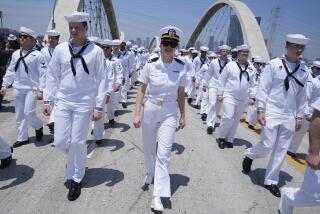Navy celebrates 100 years of aviation at San Diego Bay event
- Share via
Reporting from North Island Naval Air Station — It started humbly enough, just seven years after the Wright brothers’ flight at Kitty Hawk.
Glenn Curtiss, a brash entrepreneur and motorcycle racer from New York, was looking for a warm-weather spot to open a school to teach people how to handle these new contraptions called flying machines. He chose a marshy bit of land in Coronado, adjacent to San Diego Bay.
Navy brass, curious but skeptical, assigned a young submariner, Theodore “Spuds” Ellyson, to enroll in the Curtiss school.
What the businessman/inventor and the Navy lieutenant accomplished in the first weeks of 1911 convinced the Navy that airplanes had a military use. The two had a talent for engineering and showmanship.
When Curtiss landed his plane on the beach beside the Hotel del Coronado, the brass was impressed. And when he landed on the bay next to the cruiser Pennsylvania, Naval aviation was born.
By mid-1911, the Navy had purchased its first plane, the Curtiss A-1 Triad, built mostly of wood and cloth, with the pilot sitting in front of the eight-cylinder engine. Ellyson, a graduate of the Naval Academy, was designated as Naval Aviator No. 1 and ordered to open the Navy’s own flying school in Coronado.
Curtiss became a pioneer of the American aircraft industry, a rival of the Wrights. Ellyson’s notes from those early days in Coronado — detailed and passionate about the possibility of flight — are enshrined at the Smithsonian Institution. He held several important commands and received a Navy Cross in World War I.
On Saturday, the Navy will again salute the saga of Curtiss and Ellyson as it celebrates the centennial of Naval aviation at the location revered as its birthplace, now the North Island Naval Air Station.
The base will hold an all-day open house and air show, including a flyover of more than 200 aircraft ranging from vintage to supersonic, starting at 1 p.m. The Blue Angels, the Navy’s demonstration flying squadron, will begin the flyover. The Leap Frogs, the Navy’s demonstration parachute team, will make several jumps, including onto the deck of the carrier John C. Stennis.
On Friday, a replica of the Curtiss A-1, resident at the San Diego Aerospace Museum in Balboa Park, was brought to North Island as a demonstration. The A-1 was designed as a seaplane; the Navy would not have its first aircraft carrier for another decade.
With several of Ellyson’s relatives in the crowd, San Diego pilot Mike Steel took the craft into the bay for several quick passes on the water’s surface, reaching a speed estimated at 40 mph. For safety reasons, Navy officials had asked Steel not to attempt a takeoff. A boat with Navy rescue swimmers followed behind, just in case.
Steel, who built a seaplane for the 1995 movie “Waterworld,” said he came away with even greater respect for the daring and innovations of Ellyson and Curtiss.
“Those guys,” he said as the plane was towed to a hangar, “were true heroes.”
More to Read
Sign up for Essential California
The most important California stories and recommendations in your inbox every morning.
You may occasionally receive promotional content from the Los Angeles Times.













